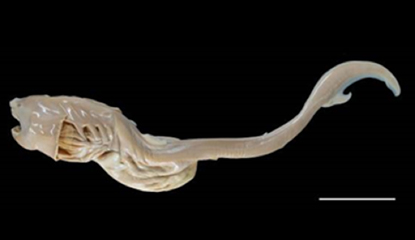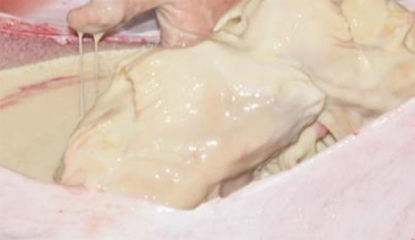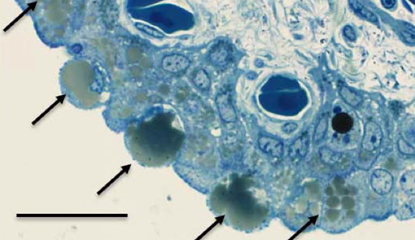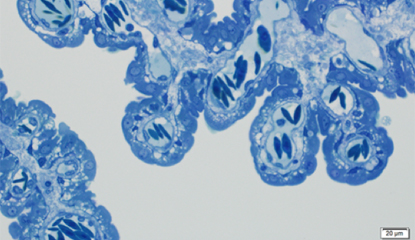MENU
- Home
- Okinawa Churashima Foundation Research Institute
- Studies of Marine Animals
- Research activity report
- Publication of an article on the mysterious reproductive mode of the great white shark.

Research on marine organisms
Publication of an article on the mysterious reproductive mode of the great white shark.
Great white sharks can reach up to 6 meters in length. They inhabit the world’s tropical and temperate seas. The great white is well known from the movie Jaws, however, its reproductive ecology is still a mystery. The main thing that is known about their reproductive mode is that they are ovoviviparous. The embryo will consume unfertilized eggs in the mother’s uterus until they have grown to around 1.3m to 1.5m in length, at which time they are born. However, there are very few examples of studies on gestation in great white sharks, and it is difficult to acquire scientific knowledge.
With the cooperation of the fishery associations within Okinawa Prefecture, who have provided bycatch sharks as research specimens, researchers at the Churashima Foundation have clarified that great white sharks have a very unusual reproductive mode.
In 2014 and 2016, researchers of the Churashima Foundation were able to dissect an undamaged specimen of a pregnant female that was bycatch in an Okinawan fishing net. Researchers analyzed the intrauterine fluid, the embryos, and its uterus. In 2014, the results made clear the early stages of great white shark gestation. The great white shark’s uterus contained 6 small individual embryos at a stage never seen before, along with a large amount of milky liquid (uterine milk) as shown in the image below.

Embryo in early stages of gestation (55cm)
Embryo found in the uterine fluid
Through histological observation, we were able to determine that a large quantity of uterine milk was composed of fat, which was secreted from the inner wall of the uterus through its villus tissue during the first stage of gestation. Uterine milk is one of the reproductive characteristics of manta rays and red stingrays, but this is the first time that its existence in sharks was revealed. In the later stages of gestation, uterine milk secretion ceases and the liquid within the uterus turns clear. During this stage the mother shark supplies a large number of unfertilized trophic eggs into the uterus so the embryos may actively feed. The embryo’s stomach will fill with the trophic eggs, allowing the embryo to grow up to 1.3 to 1.5 meters. As this occurs, the villus tissues in the inner wall of the uterus have a similar form to that of a fish gill and specialize in supplying oxygen to the uterus. From this research, we are able to understand the complex changes that take place in the structure and functions of the uterus during the gestation period.

Blackish lipid droplets (arrows) round in shape and various sizes were seen in the uterus epithelium during early gestation phase.
Many blood vessels localized in the uterine lamellae, but no lipid droplet was observed in late gestation phase.
Because of our research, we are able to confirm one aspect of the reproductive mode of the great white shark. However, there are many things that are still unknown about the ecology of great white sharks including breeding grounds, the distribution of the pregnant sharks, and the places where they give birth. These questions are not restricted to the great white, but common across other species of sharks. We believe the results and data acquired through this research will be of great importance in conducting a variety of shark research and conservation management.
Authors
Keiichi Sato, Masaru Nakamura, Taketeru Tomita, Minoru Toda, Kei Miyamoto and Ryo Nozu (Bold letters:Foundation staff member)
Title
How great white sharks nourish their embryos to a large size: evidence of lipid histotrophy in lamnoid shark reproduction
Journal
Biology Open 2016 5: 1211-1215; doi: 10.1242/bio.017939
Link
http://bio.biologists.org/content/5/9/1211
Copyright (c) 2015 Okinawa Churashima Foundation. All right reserved.

